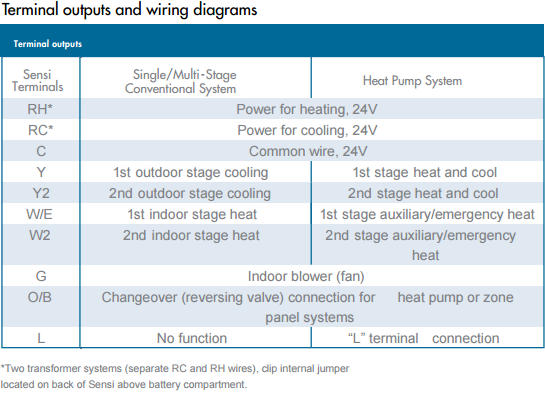Why is my cooling running constantly?
If you’ve installed the Sensi thermostat and now find that your cooling system is running constantly, proceed through the following steps until the issue is resolved.
First, determine if the issue is with the thermostat.
- Set your thermostat Mode to Off and Fan to Auto. When the thermostat is set to Fan On it may sound like the heating or cooling is running even when it isn’t.
- If your system still runs after 1-2 minutes, remove the thermostat and check the wiring.
- Remove the thermostat face plate from the sub-base. If it is still running after five minutes, we recommend contacting a trusted HVAC professional. There may be a short in the wiring to the equipment.
- Check each wire connection on the wall plate, and make sure they’re secure in the terminal blocks.
- Make sure the wires are not touching each other. No bare wire should stick out from under screw terminals.
-
If the system turns off while the thermostat is removed, reset the thermostat by removing the batteries located in the back of the face plate. Press the “Menu” button until the screen goes blank, and then reinstall the batteries.
-
Now test your thermostat.
-
Working directly on the thermostat – not through the Sensi app – set the thermostat to the Cool Mode.
-
Raise the set point a few degrees above the room temperature.
-
Within a few seconds, the thermostat should make a soft clicking sound and “Cooling” should disappear from the screen near the set temperature, indicating that your thermostat is operating properly.
-
If your system is still not turning off, confirm that you labeled and installed your wires properly.
Does your old thermostat have two sets of terminal labels? Learn more here and be sure you’re entering the correct terminals that correspond to your system type (Conventional or Heat Pump). The table below shows what each terminal letter represents.

Then, check that your Sensi thermostat is configured correctly for your system type.
When completing the installation and connection path within the Sensi app, your thermostat will be configured automatically based on the wiring that you entered. However, if you do not complete the connection process right away, or if your thermostat is wired incorrectly, it may need to be reconfigured to reflect your system type.
- On the thermostat, press the Menu button.
- Press “Next” two times until you reach “Setup Outdoor.”
- Outdoor settings: If you have a heat pump, this should be set to “HP1.” If you have a conventional air conditioning unit, this should read “AC1.” If you have more than one stage of cooling, change this to “HP2” or “AC2” to represent this. Press “Next” to reach “Setup Indoor.”
- Indoor settings: If you have a gas furnace, oil burner, or boiler system, this should be set to “GA1” which represents a single stage gas heating system. If you have an electric furnace, this should be set to “EL1.” If you have more than one stage, change this to “GA2” or “EL2” to represent this.
- Once you’ve selected the choice that best describes your equipment, press “Exit.”
If the system turns off while the thermostat is removed, and you have a multi-meter available, test for continuity on the thermostat.
- Set the multi-meter to Ohms (Ω).
- Make sure the face plate is set for Fan AUTO and Mode OFF.
- Now test for continuity on the pins on the back of the thermostat face platefrom RC or RH to the terminals corresponding to the device running (G – fan, W/E – furnace, Y – compressor).
NOTE: DO NOT TEST CONTINUITY ON THE THERMOSTAT SUB-BASE TERMINALS OR THE MULTIMETER WILL BE DAMAGED. - For your fan or compressor running constantly, make sure to test between RC and Y and RC and G. Put one test probe on the pin labeled RC and the other test probe on the pin labeled Y.
- If continuity is detected when set for Fan AUTO and Mode OFF, replace the thermostat.
- If continuity is not detected, the thermostat is operating properly and not calling for the corresponding system component.
- If continuity is not detected, and replacing the thermostat face plate makes the system run continuously again, your system may have a sensitive equipment circuit that is reacting to the power sharing feature in the thermostat. Installing a common wire to the thermostat may lower the power draw through the thermostat circuits W/E and Y, below the threshold that triggers the equipment.
- For options for adding a common wire, please check out our c-wire picker web application.
Reach out to us
Our customer support is available 7 days a week.
